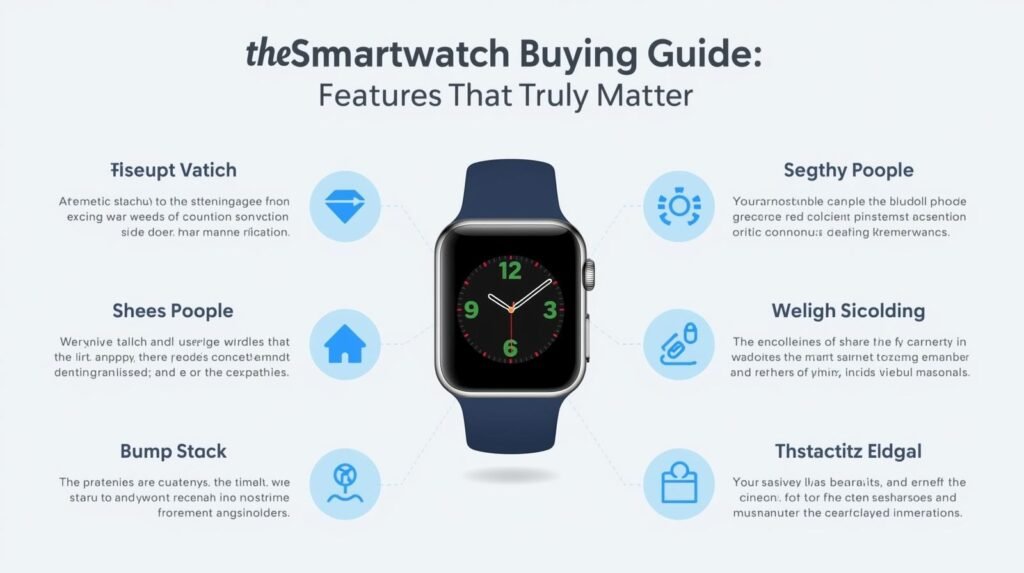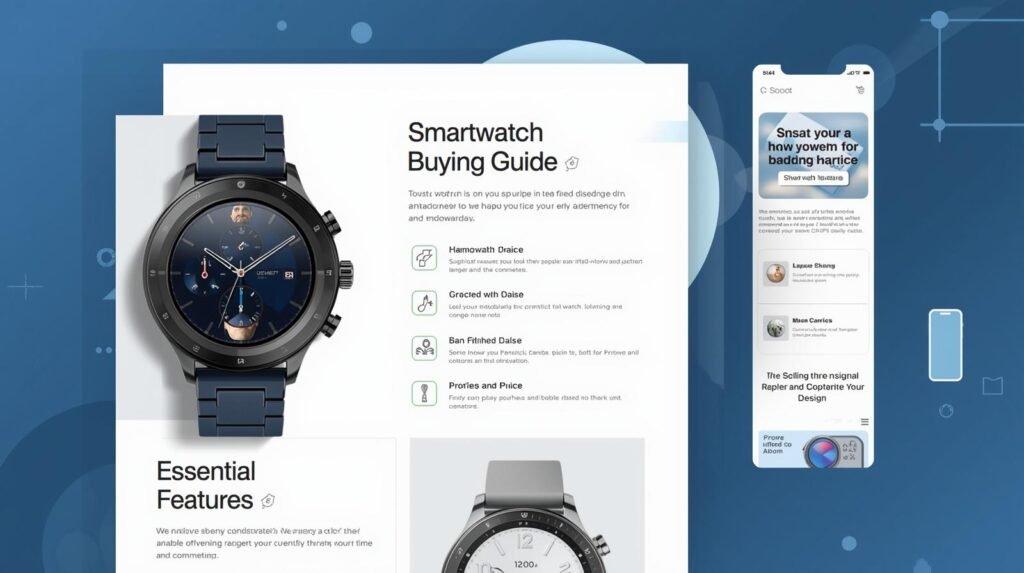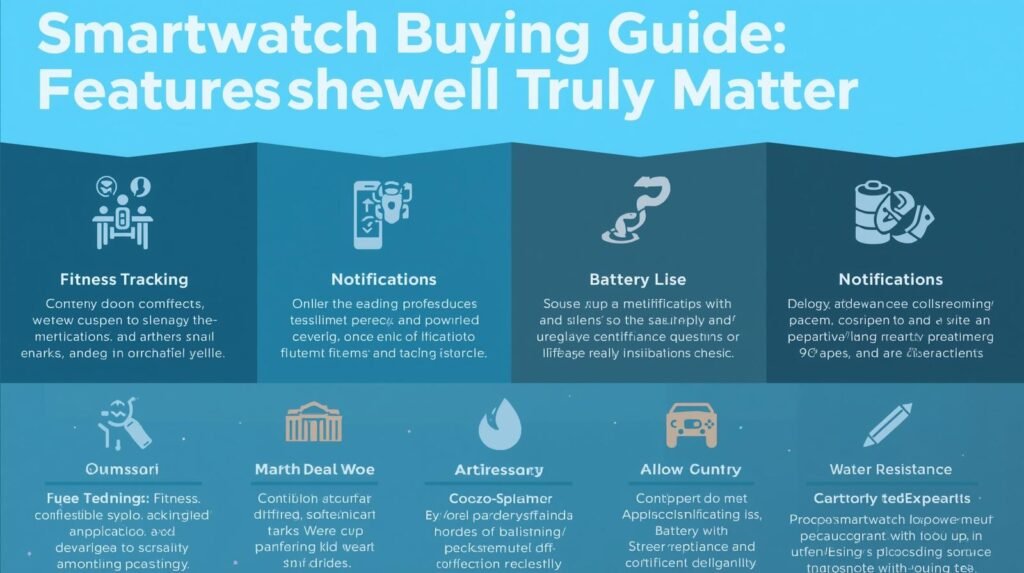
The world of wearables has evolved far beyond simple step counters. Smartwatches have become powerful mini-computers strapped to our wrists. They help us stay connected, track our health, monitor fitness, make payments, and even manage stress — all while telling the time.
But with hundreds of models on the market — from budget-friendly options to luxury devices — choosing the right smartwatch can feel overwhelming. Whether you’re a fitness enthusiast, a busy professional, or a tech lover, the right smartwatch can make your life easier and healthier.
This Smartwatch Buying Guide 2025 breaks down everything you need to know — from the must-have features and hidden specs to battery life, compatibility, and the latest innovations that truly matter.
🕒 1. Why You Need a Smartwatch
A smartwatch is no longer a luxury — it’s a lifestyle companion. Modern smartwatches act as extensions of your smartphone, health coach, and even personal assistant. Here’s why millions of people are upgrading to smarter wearables this year:
- Health Tracking: Monitor heart rate, blood oxygen (SpO2), stress, sleep, and even ECG readings.
- Fitness Goals: Track workouts, calories, steps, and recovery data.
- Notifications on the Go: Get calls, messages, and app alerts instantly.
- Convenience: Make payments, control music, or reply to messages without touching your phone.
- Style: Smartwatches now come in elegant, customizable designs that match any outfit.
Whether you want to improve your fitness, boost productivity, or simply look good — a smartwatch can make a big difference.
⚙️ 2. Key Factors to Consider Before Buying
Before diving into specs and features, consider your personal needs. Not all smartwatches are built for everyone — some excel at fitness tracking, others at productivity or fashion.
Ask yourself:
- Do you want advanced health tracking (like ECG or stress monitoring)?
- Are you focused on fitness and sports performance?
- Or do you simply want a stylish companion for daily use?
Let’s go through the most important features that matter in 2025.
🧠 3. 1. Compatibility: Does It Work With Your Phone?
The first and most important thing to check is compatibility.
- Apple Watches work best with iPhones. They can connect to Android, but functionality is limited.
- Samsung Galaxy Watches are optimized for Android (especially Samsung phones).
- Wear OS watches (by Google, Fossil, or Pixel) work with both Android and iOS.
- Garmin, Amazfit, Fitbit, and Huawei watches usually connect to both, though iPhone integration may be slightly reduced.
👉 Tip: Always check if the app (like Samsung Health, Fitbit, or Huawei Health) is available and compatible with your phone’s operating system.
💪 4. 2. Health and Fitness Tracking
If you’re buying a smartwatch in 2025, chances are you care about your health. Today’s devices offer advanced sensors that rival medical-grade monitors.
Key Health Features to Look For:
- Heart Rate Monitoring: Tracks your heart rate 24/7 and alerts you to abnormalities.
- Blood Oxygen (SpO2) Monitoring: Measures oxygen levels — useful for workouts or sleep tracking.
- ECG (Electrocardiogram): Detects irregular heart rhythms like atrial fibrillation (AFib).
- Stress Tracking: Uses heart rate variability (HRV) to measure stress levels and suggest relaxation techniques.
- Sleep Tracking: Breaks down sleep stages (light, deep, REM) and gives insights for improvement.
- Menstrual Cycle Tracking: Helps women predict cycles and symptoms.
Fitness Features:
- Step Counter: Tracks your daily movement.
- Workout Detection: Automatically recognizes workouts (like running, cycling, or yoga).
- GPS Tracking: Measures distance and routes accurately.
- VO2 Max & Recovery: For athletes, these metrics indicate endurance and recovery readiness.
If health is your priority, choose watches like Apple Watch Series 10, Samsung Galaxy Watch 7, or Garmin Venu 3 — all equipped with top-tier health sensors.
🏃♀️ 5. 3. Fitness and Sports Modes
Modern smartwatches are fitness coaches on your wrist. They track every activity — running, swimming, cycling, yoga, hiking, or gym workouts — and provide detailed performance stats.
Look For:
- Multi-Sport Tracking: Supports dozens (sometimes 100+) of activities.
- Automatic Detection: Starts tracking when you begin moving.
- Water Resistance: Essential for swimmers (look for 5ATM or IP68 ratings).
- Custom Workout Profiles: Create your own training sessions.
- Performance Metrics: Pace, elevation, cadence, recovery, and heart rate zones.
For sports lovers, Garmin Forerunner, Amazfit T-Rex Ultra, and Polar Vantage series are fantastic options.

🔋 6. 4. Battery Life: The Unsung Hero
Battery life is one of the most overlooked — yet most critical — aspects of a smartwatch.
General Ranges:
- Apple Watch / Wear OS: 18–48 hours (depends on usage).
- Samsung Galaxy Watch: 1–3 days.
- Fitbit / Amazfit / Garmin: 7–20 days.
If you hate charging frequently, go for models like Amazfit GTR 4 or Garmin Instinct 2, which last for weeks on a single charge.
👉 Pro Tip: Always check if the watch supports fast charging — many newer models give you a full day’s charge in just 15–20 minutes.
📱 7. 5. Display Quality and Size
A smartwatch display determines how easy it is to read notifications, track workouts, and navigate apps.
Display Types:
- AMOLED / Super AMOLED: Bright, vibrant, and energy-efficient — ideal for all lighting conditions.
- LCD: Affordable but less contrast and brightness.
- Always-On Display (AOD): Lets you see time or data without waking the screen.
Display Size:
Choose a size that fits your wrist comfortably.
- 40–42mm: Best for smaller wrists.
- 44–47mm: Ideal for larger wrists or those who prefer bigger screens.
Resolution & Brightness:
A good display should have at least 400×400 pixels and 500+ nits brightness for outdoor visibility.
⌚ 8. 6. Build Quality and Design
Smartwatches today are as much about fashion as function. Most brands offer customizable options — from straps to watch faces.
Build Materials:
- Aluminum: Lightweight and stylish.
- Stainless Steel: Premium and durable.
- Titanium or Ceramic: High-end and scratch-resistant.
- Plastic/Polymer: Lightweight and budget-friendly.
Straps:
Choose between silicone (sporty), leather (formal), or metal (classic). Many models now support quick-release straps, allowing you to swap styles easily.
💬 9. 7. Smart Features That Truly Matter
A smartwatch is “smart” because of its ecosystem of apps and features. Let’s look at the most practical ones in 2025.
Essential Smart Features:
- Notifications: Calls, messages, and social media alerts directly on your wrist.
- Quick Replies: Reply to messages using voice, pre-set responses, or emojis.
- Music Control & Storage: Play music or connect Bluetooth earbuds directly.
- Voice Assistant: Siri, Google Assistant, or Bixby for hands-free control.
- Find My Phone: Instantly locate your smartphone.
- NFC Payments: Make secure payments using Apple Pay, Google Pay, or Samsung Pay.
- Offline Mode: Download maps or playlists for workouts without your phone.
Some advanced watches even let you take calls directly via Bluetooth or LTE, perfect for joggers who prefer leaving their phones behind.

🌐 10. 8. Connectivity and Performance
Connectivity Features:
- Bluetooth 5.0+: Ensures faster and more stable connection.
- Wi-Fi: Allows syncing without a phone nearby.
- GPS / GLONASS / Galileo: For accurate navigation and tracking.
- LTE / 4G Support: Use the smartwatch independently (great for outdoor runs).
Performance:
Look for watches with powerful processors (like Apple’s S9 or Qualcomm Snapdragon W5+) and at least 1GB RAM for smooth multitasking.
Pro Tip: Avoid budget watches with laggy performance — they often compromise the experience even with fancy features.
🔐 11. 9. Safety and Emergency Features
Safety has become a crucial part of modern wearables.
Key Features to Look For:
- Fall Detection: Alerts emergency contacts if you fall or stop moving.
- SOS Alerts: Send your live location with one tap during emergencies.
- Heart Rate Alerts: Notifies you of abnormal readings.
- Temperature Sensor: Detects fever or body temperature fluctuations.
Apple Watch, Samsung, and Garmin all lead in these life-saving innovations.